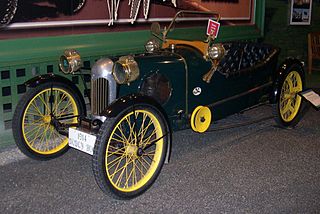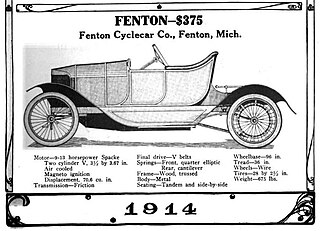Related Research Articles

A cyclecar was a type of small, lightweight and inexpensive motorized car manufactured in Europe and the United States between 1910 and the early 1920s. The purpose of cyclecars was to fill a gap in the market between the motorcycle and the car. A key characteristic was that it could accommodate only two passengers sitting in tandem.

The Argo was a short-lived American automobile manufactured by the Argo Motor Co in Jackson, Michigan, between 1914 and 1918. Previously, the factory had been used by the Standard Electric Car Co to build an electric car.

Coventry Premier Limited owned a British car and cyclecar manufacturing business based in Coventry from 1912 to 1923. It changed its name from Premier Cycles to Coventry Premier Ltd in November 1914.

The Xenia was an American cyclecar designed by P. E. Hawkins of Cleveland and manufactured in Xenia, Ohio in 1914. The factory was Fred Baldner's machine shop, in which Baldner manufactured his own car from 1900 to 1903.

The LuLu cyclecar was produced by the Kearns Motor Truck Company in Beavertown, Snyder County, Pennsylvania from 1914 to 1915.
The Davis was an American cyclecar manufactured in Detroit, Michigan, by the Davis Cyclecar Company in 1914. The car used a two-cylinder Spacke air-cooled engine, and featured three-speed selective transmission and a double chain drive on a 93-inch wheelbase. The Davis was similar to the French Bédélia in that the driver sat in the rear seat. The tandem two-seater cost $425, but designer William Norris Davis was unable to secure the capital to undertake production. He moved to the West Coast and joined the Los Angeles Cyclecar Company.
The Detroit Cyclecar was a cyclecar manufactured in Detroit, Michigan by the Detroit Cyclecar Company from 1913 to 1914 and Saginaw, Michigan in 1914.

The Dudly was a Brass Era, gas-powered cyclecar manufactured in Menominee, Michigan, by the Dudly Tool Company from 1913 to 1915. The Dudly had an ash-wood frame, two-seater open model that was originally offered with a two-cylinder air-cooled engine. The 1914 Dudly was offered with a four-cylinder 1.6 L engine.
The Engler was an American cyclecar manufactured in Pontiac, Michigan by the W.B. Engler Cyclecar Company from 1914 to 1915. The Engler was a two-seater cyclecar that used a DeLuxe air-cooled, a 1.2L two-cylinder engine. The vehicle had a friction transmission and belts, and cost $385.
The Excel was an American cyclecar manufactured in Detroit, Michigan by the Excel Distributing Company in 1914. The two-seater cyclecar weighed 1,000 lb (450 kg), and had a 1.5 L water-cooled four-cylinder engine. It was driven by a friction transmission with belts.

The Partin Manufacturing Company was a brass era American automobile manufacturer, headquartered at 29 South LaSalle Street, Chicago, Illinois from 1913 to 1917. The Partin-Palmer automobile and Pioneer cyclecar were produced.

The W. H. Kiblinger Company and the W. H. McIntyre Company produced Brass Era automobiles in Auburn, Indiana from 1907 to 1915.
The Greyhound Cyclecar Company was created in 1914 in Toledo, Ohio.

The Warren-Lambert Engineering Co. Ltd. was a British automobile manufacturer that was established from 1912 to 1922 in Richmond, then in Surrey. A. Warren Lambert, was an agent for Morgan cars in Putney which he also raced. In 1912 he designed and started to manufacture a two-seat four-wheel cyclecar from premises in Uxbridge Road, Shepherd's Bush. It was well received and around 25 cars a week were being made.

The Pope Model L was a motorcycle produced by Pope Manufacturing Company in Westfield, Massachusetts, between 1914 and 1920.
The Brass era Robie cyclecar was manufactured by the Robie Motor Car Company in Chicago, Illinois in 1914.

The Saginaw cyclecar was built by the Valley Boat & Engine Company of Saginaw, Michigan in 1914.

The Signet cyclecar was the name used by Fenton Engineering Company of Fenton, Michigan from 1913 to 1914. In 1914 the name was changed to Fenton and was manufactured by the Fenton Cyclecar Company. In May 1914, The Fenton became the Koppin and was produced by the Koppin Motor Company until September 1914.
The States was a cyclecar manufactured by the States Cyclecar Company of Detroit, Michigan in 1915.
References
- G.N. Georgano (1968). The Complete Encyclopedia of Motorcars, 1885 to present . New York, Dutton.[ page needed ]